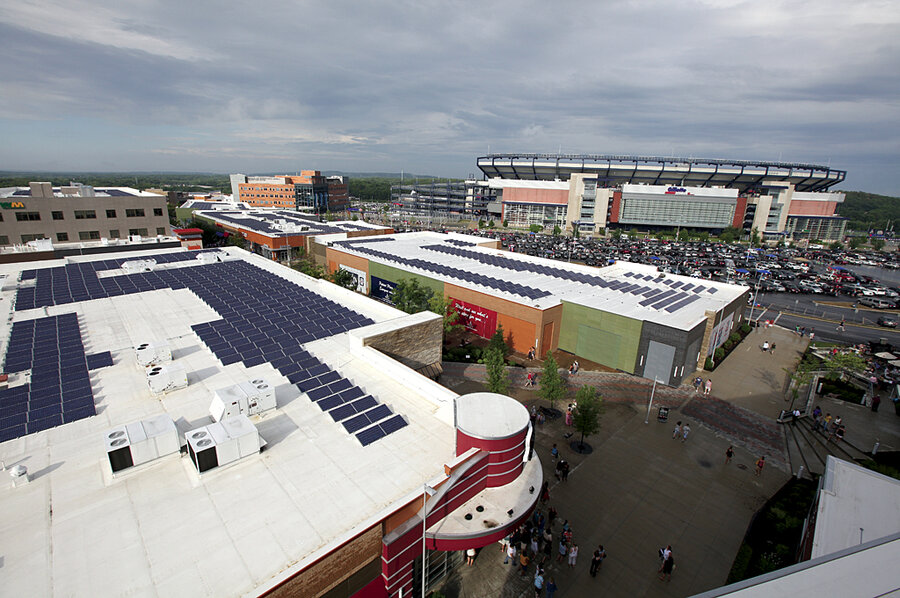As Patriots (and pro sports) go solar, will fans follow?
Loading...
When New England Patriots fans return to Gillette Stadium in Foxboro, Mass., for Monday's preseason game, dreaming no doubt about another shot at the Super Bowl, they'll be greeted by nearly 2,600 rooftop panels pointed at the sun. The Patriots, known for their smart tactics on the field, are switching to solar power for their off-field shopping and dining complex next door to the stadium.
What's going on? Is pro football going "green"? Are premier smash-mouth athletes really tree-huggers with shoulder pads?
The Patriots are just the latest in a growing number of professional sports teams going solar. From the Cardinals baseball stadium in St. Louis to the Los Angeles complex housing that city's basketball and hockey teams, franchises are using their big flat-roofed buildings and vast parking lots to cut their power bill. The bigger question is: Will their fans follow suit?
So far, residential solar installations lag far behind commercial ones. For example: 60 percent of the energy used by the Patriots' complex, known as Patriot Place, will come from the sun; the number is less than 0.1 percent for the average resident of Greater Boston. Economics and logistics explain part of the growing disparity. It's easier and cheaper to install panels on flat roofs and acres of parking space than on the average American home. But it also has to do with perception.
"People don't yet see [solar] as a normal thing," says Mark Jacobson, director of the Atmosphere/Energy program at Stanford University in Stanford, Calif. "But if they see more examples of it, they aren't going to feel weird" about using solar power for their own homes.
That's the hope, anyway.
For pro sports complexes, solar energy and other clean power sources are quickly becoming the norm. Last September, the Washington Redskins franchise installed a two-megawatt solar array at FedEx Field, involving 8,000 solar modules that double as canopies in the stadium's parking lots. The setup provides an estimated 20 percent of the complex's power on game days, according to NRG Solutions, a New Jersey-based energy company that engineered the solar installations at FedEx Field, Patriot Place, and several other pro sports facilities.
In Seattle, now-bankrupt solar company Solyndra installed a 2.5-acre solar array on the roof of the Seahawks' Qwest Field event center. In Philadelphia, plans are well under way to make Eagles home turf Lincoln Financial Field the greenest of them all, with the addition of 11,000 solar panels and 14 wind turbines.
In Major League Baseball, the St. Louis Cardinals, Kansas City Royals, Boston Red Sox, and San Francisco Giants boast solar arrays at their facilities. The Staples Center in Los Angeles – home to the National Basketball Association's Lakers and Clippers, and the National Hockey League's Kings – has had a 1,727-panel rooftop solar array since 2008.
Residential installations have more than doubled since 2010, but Mr. Jacobson estimates that residential solar is at least three times as expensive as large commercial installations. "So a $6-per-watt bid on a home might be $1.75 or $2 on a commercial building," he adds.
Costs are coming down, however. The average price of a solar panel has dropped 50 percent in the previous year, according to the Solar Energy Industries Association.
Another issue: space. Sports complexes have or can build a wide variety of flat-topped structures that can accommodate, or be made into, solar arrays. Options on the average American rooftop are far more limited, which means smaller power generating potential. The average rooftop solar array is around 5 kilowatts, requiring 500 square feet of unobstructed roof space.
Then there's financing. The federal government offers a 30 percent tax credit off the cost of a solar installation, with no maximum. But many homeowners may not owe as much in taxes as they would earn from the solar tax credit. SunRun, a California-based company that leases out solar arrays, notes on its website that if a household installs $45,000 worth of solar panels, they would have to have at least a $13,500 tax bill to take full advantage of the federal solar credit. And many families can't foot the bill for the still-steep upfront costs of solar, even if the investment will pay for itself in the long term.
Still, other options are becoming available, including leasing panels and pitching in with neighbors to get a bulk rate. If the National Football League, with its huge fan base and commercial reach, can convince Americans to look into the idea, residential solar could take a big step forward.
Stadium solar panels are "a high profile demonstration to a mass consumer audience that clean energy choices are here today," Tom Gros, president of solar-installer NRG Solutions, writes via e-mail. "Stadiums may be big, but this project shows that any business with a parking lot or roof space can cut costs through renewable energy."







